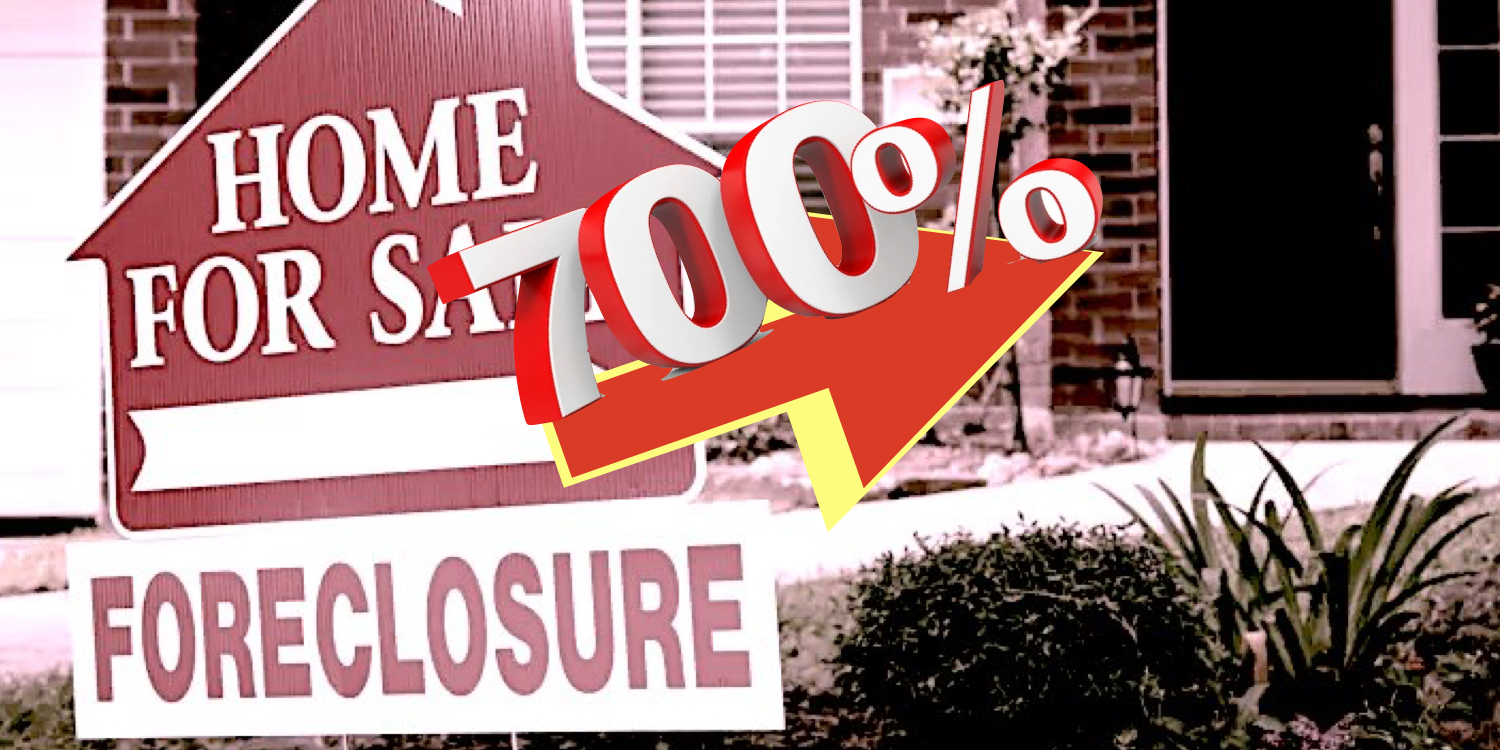Has the housing market crash been canceled? That is the question many real estate and mortgage professionals are asking after a year of housing crash predictions have failed to materialize- at least nationwide
Continue readingA closer look at September’s HECM Endorsement data
Unable to use the embedded player? Listen here.
EPISODE #743
Moodys says these 210 housing markets could crash 25-30%
[Fortune] “Moody’s Analytics expects that U.S. home price decline to widen to between 25% to 30% in 210 “significantly overvalued” housing markets.
Other Stories:
-
Homebuilder sell-off to impact neighborhood home values
-
A closer look at September’s HECM Endorsement data
What’s offsetting lower HECM PLFs
Despite rising rates and lower PLFs, HECM opportunities abound. Here’s why…
Continue readingForeclosure starts surge 700%
Foreclosure starts are up 702% from December to January with 32,900 loans. What does this mean for the housing market and reverse mortgage lenders?
Continue readingPodcast E646: How COVID vaccines could upend the housing market
Unable to use the embedded player? Listen here.
How COVID-19 Vaccines will Upset the Housing Market
The coronavirus pandemic has dramatically changed the landscape of the housing market- especially in urban areas. Here’s how COVID-19 vaccines in 2021 are poised to upset housing trends once again.
Other Stories:
-
COVID has slowed but hasn’t stopped FHA’s search for a new servicer
5 Reasons to be Excited!
In the early spring, you may have been ‘locked down’ working remotely in response to the COVID-19 pandemic and caught a case of cabin fever in the process. Perhaps you over-indulged in binge-watching Netflix to pass the time you would have typically spent going out to social functions. Regardless of what your current situation may be, reverse mortgage professionals have good reason to be excited, grateful, or just simply relieved. Here are five to consider.
Lending Limits are both national and remain high
Despite repeated recommendations to roll back the national lending limits back to regional or county-by-county maximums, today we enjoy a robust $765,600 maximum claim amount (MCA). This is the cap on the maximum appraised home value that can be considered in calculating a federally-insured HECM’s gross principal limit. Fortunately, it covers the majority of homes in most U.S. markets. Eliminating the national MCA in favor of local caps literally requires an ‘act’ of Congress. Both the upcoming election and ongoing stimulus measures have eclipsed addressing any such consideration presently.
Housing prices are booming
A general shortage of housing inventory and record-low interest rates have home prices reaching record heights, some not seen since the 2008 housing crash. Both HECM and proprietary reverse mortgage borrowers are in an advantaged position to tap their home’s value at what may be the peak of the market. Homeowners struggling to pay their existing mortgage may find themselves now able to qualify based on their latest value and low interest rates. The question many market watchers are asking is if the boom will continue or if values will fall.
Historically-low interest rates
Although HECMs will soon be moving away from the LIBOR, all global indexes are setting record lows as governments take stimulus measures to boost their economies struggling in the wake of the coronavirus and economic shutdowns. In some instances, low rates and high home values have all but erased the impacts of the infamous October 2017 reduction of principal limit factors (lending ratios).
When the interest rate floor of the HECM was lowered from 5 to 3 percent we lamented the drop believing we would never see effective interest rates reach such a low. A few short years later many HECM loans are hovering at or just below a meager three-percent.
Financial Advisors seeking alternatives
The stock market’s volatility remains fresh in the minds of both the financial professional and their clientele. Those who once eschewed reverse mortgages are coming around to the realization that all options should be put on the table to form a plan that accounts for stock market volatility, inflation, and sustainable withdrawals. Now could be the time to rekindle your connections with advisors in your market.
HECM-to-HECM refinances
Late last year HUD proposed that FHA move to eliminate all HECM-to-HECM refinances. Fortunately, FHA made no such change. Today nearly one-third of all HECM applications are refinance transactions as borrowers harvest additional funds from their home. As a result, refis have become a significant driver of ordination volume and profitability.
Certainly, we face much uncertainty, however, we have much to be grateful in the midst of the storm. Count your blessings- at least five of them.
Home Values? 4 Factors to Watch
These are the 4 factors that will change home values this year
1. DEMOGRAPHICS–
Demographics are the data that describes the composition of a population, such as age, race, gender, income, migration patterns, and population growth. These statistics are an often overlooked but significant factor that affects how real estate is priced and what types of properties are in demand
Urban flight in the wake of COVID-19 lockdowns, closed businesses, widespread civil unrest, riots, and increasing tax burdens in our largest cities. For example, since July 2019 rents are down 10% in Manhattan as former downtown residents move to the surrounding boroughs, to the suburbs, or out of the state.
2. INTEREST RATES-
Today’s average interest rate on an adjustable-rate HECM range from… [read more]
…2.9% to 3.5% depending on the margins offered by the lender. For a 72-year-old man with a $350,000 home, a 3.125% rate would give him a gross principal limit (that’s the funds available before liens, fees, and set-asides) of $202,300… Before the pandemic and central banks slashing rates that the same individual would only qualify for $180,000 with a 4.125% interest rate. That’s a 12 percent reduction in loan proceeds.
Last Thursday Federal Reserve Chairman Jerome Powell announced a policy shift saying the Fed will focus on ‘average inflation targeting’. in essence, this means the prior target of 2% inflation which would typically trigger a rate hike is being abandoned for a higher inflationary tolerance. This means interest rates are expected to remain low for the foreseeable future- the Dow Jones spiked up 300 points in the hours following this announcement.
3. ECONOMIC PERFORMANCE & OUTLOOK. The US. GDP dropped by over 30% in response to the nationwide shutdown to slow the spread of the coronavirus. The GDP is not expected to dramatically improve as today marks Day 168 from the original 15 Days to Slow the Spread which was enacted on March 16th.
4. GOVERNMENT INTERVENTION. Tax credits- stimulus measures. Unemployment may rise when some employers find that some if not all of their forgivable Paycheck Protection Program monies received may be taxable. After 20 interim rule changes to the CARES Act, it’s quite apparent the program is literally evolving before our eyes. The IRS took that position in Notice 2020-32, stating that expenses otherwise deductible in a borrower’s trade or business are not deductible if they result in loan forgiveness under a PPP loan. This could lead to further layoffs for cash-strapped employers who took a PPP loan.
All which leads us to the conclusion that at this very moment, despite the pandemic and economic uncertainty, we are in an ideal lending environment to qualify the greatest possible number of potential homeowners for a reverse mortgage.
[/read]
It’s only up from here
If we’re at the new norm of industry-low volume, what’s next?
Reverse Market Insight’s recap of June 2019 endorsements states, “2,500 endorsements per month is the default volume setting for the industry right now”. Calculate that out and that would equate to a new low in annual HECM endorsements totaling just over 31,000 loans insured by the FHA this fiscal year (which ends September 30, 2019).
“It’s only up from here” (anonymous)
If there’s a silver lining it would be that perhaps we’ve reached a functional low for HECM loan volumes. Functional in the sense that the remaining large lenders and brokers have found a way to succeed in today’s market.

For those watching our industry’s volume plummet with a growing sense of unease, consider the following:
- Our distribution network has been sharply reduced with the exit of Wells Fargo, Bank of America, MetLife, Generation Mortgage, and most recently LiveWell Financial.
- We no longer have a national brick & mortar distribution network with the absence of the largest national banks who once marketed and originated HECMs.
- Loan proceeds have been reduced considerably with a series of principal limit factor reductions that began in 2009 and accelerated in subsequent years with the most recent reduction in October 2017.
- Only one national lender is consistently seen on American’s TV sets; AAG’s Tom Selleck ads continue in the lender’s national marketing campaign.
- Private or proprietary reverse mortgages are gaining popularity; just how much remains to be seen as lenders are not reporting loan volumes presently. The increasing popularity of these loans may be slightly depressing HECM volume.
- Interest rates remain low and further cuts to the federal funds rate are anticipated which may impact the LIBOR rates used on Home Equity Conversion Mortgages to the point where we breach the 3% interest rate floor. Prior to October 1, 2017, the HECM interest rate floor was 5%. Notwithstanding any further PLF cuts, this should increase borrower proceeds.
- The U.S. median home price was $334,400 in Q4 of 2013 and stands at $377,700 in Q1 of 2019. That’s a 12-percent increase on average, with several markets, far exceeding the median price.
- While principal limit factors (PLFs) have been reduced 30% on average since 2013, increasing home values have offset the net reduction to an approximate 12-percent net reduction in proceeds using today’s current PLFs compared to the 2013 tables which stopped at 5% (interest rate floor).
- Select originators are reporting an increase in monthly loan volume.
Barring any further reduction of PLFs or additional restrictions, we may have tested the bottom of the lowest volume of HECM loans. If that is the case, it’s only up from here.
A Bigger Pie – Expanding Our Marketshare
Larger Market = More Qualified & Interested Borrowers
[ad#Network Funding]
[vimeo id=”78962141″ width=”625″ height=”352″]

It’s a marketshare problem. As an industry we have been negatively impacted by falling home values, cuts in lending ratios or principal limits, elimination of products and borrower qualification guidelines. In 2009 over 114,000 reverse mortgages were endorsed versus only 54,000 in 2012. Consequently we can easily point to any of these factors as the leading cause of our lack industry volume. But are we not seeing the forest through the trees? One well-respected industry leader told me “I don’t want a bigger piece of the pie but a bigger pie itself”. Otto Cushman, CEO of Liberty Home Equity Solutions was quoted in Reverse Review’s article entitled “Extreme Summit” saying “ Less than 1% penetration, We are failing”. He backs his assertion comparing 50,000 endorsed loans in 2013 to 200,000,000 [correction made from 200,000] qualified senior households with sufficient equity equally a paltry one quarter precent of available marketshare. It’s boils down to the law of numbers. The same principle that motivates us to look at how many leads it takes to generate X amount of loans per month should be our approach to marketshare. More positively interested potential borrowers equals more loans. So where do we beign?
Reverse Mortgage News, Training & Technology at ReverseFocus.com
State of Appraisals
What are the challenges with appraisals? We all face them every day. Our interview with Erik Richard of Landmark Network (AMC) sheds light on appraisal management, home values and more.
Continue reading













